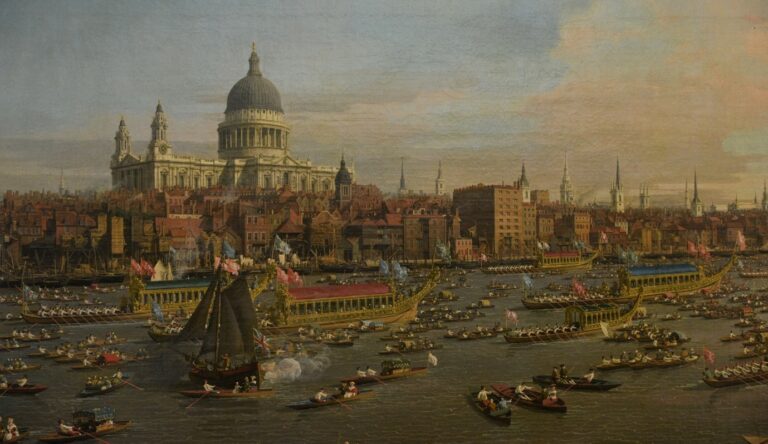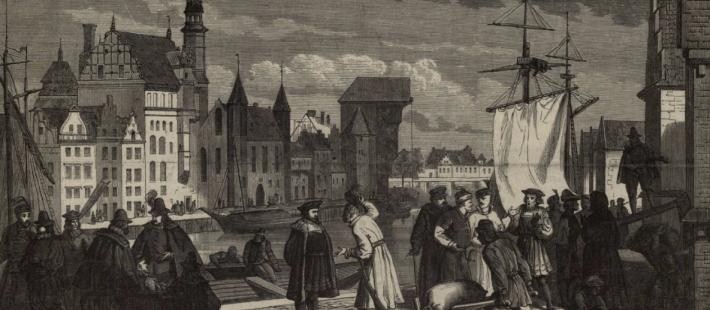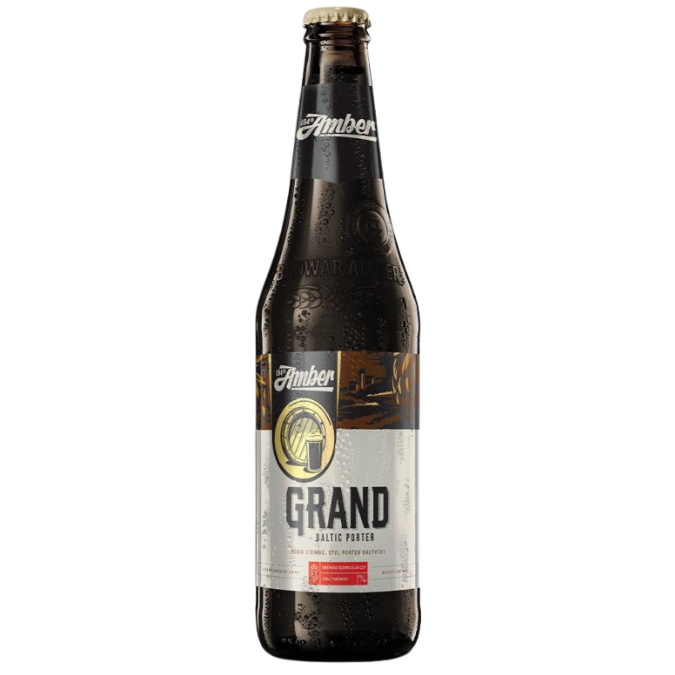From this article you will learn:
- When was Baltic porter born?
- When did porter become an export product?
- When did porter brewing begin in the Baltic Sea region??
- What did Napoleon have to do with porter?
- What did the Russians have to do with porter?
- Top or bottom-fermented porter?
- Why and when did porter lose its popularity?
- When did porter revival happen?

The birth of Baltic porter
Baltic porter is a style that was born partly out of necessity, partly out of longing and partly out of a desire for profit. Let’s start from the beginning
London, early 18th century. Brown ale had been the dominant beer there for many years. Heavy, sweet, lightly hopped, with smoky notes from brown malt achieved by drying grain using wood. The rise in malt prices due to increased taxes, as well as competition from new, paler and crispier beers, forced London brewers to make changes. They created a new beer that was lighter, more heavily hopped, longer matured, crispier and more drinkable. Longer maturation removed smoky flavours, and wild yeast present in the barrels increased dryness and added fruity aromas.

The new beer proved particularly popular with the workers known as porters, the couriers of the day, who delivered parcels all over London. Their work was hard and demanding, so they needed a robust, satiating beer. They drank so much of it that the new beer quickly adopted the name porter, after its main consumers.
It quickly became popular throughout England and porter breweries grew rapidly, bringing considerable wealth to their owners.
Porter as an export commodity
At the end of the 18th century, the biggest, richest and most innovative breweries in the world were in fact London breweries brewing porter. It was also an important export commodity, reaching all corners of the British Empire. Including the countries around the Baltic Sea basin, at least from around 1760.
We know that large quantities of porter were delivered to the ports of Klaipéda and Gdańsk, from where it was distributed inland. It was an exclusive beer, several times more expensive than domestic brews. No wonder that brewery owners wanted to produce similar beer at home in order to get at least a small share of this market.

Porters brewed in the Baltic
The first porters brewed in the Baltic Sea region were created in Sweden, possibly as early as 1774. By 1790, there were already porter brewing breweries in St Petersburg and Gothenburg. In Poland, Karol Wilhelm Schmidt was probably the first brewer to brew porter. He learnt how to make in in England, where he spent two years. When he returned to Poland, he introduced innovations he had seen in the British Isles, including the first wort cooler in Poland.
However, the first porters brewed in Poland based on the English model did not gain much recognition, losing out to imported beers. No wonder, after all, English porters had an excellent reputation and were brewed by rich and modern breweries. There was also a belief that a real, good porter could only be brewed with water from the Thames.
Napoleon Bonaparte and porter
At the beginning of the 19th century, English porter was served in every major city and every respectable inn. However, in 1806 something disrupted this state of affairs. Emperor Napoleon Bonaparte imposed a continental blockade, which stopped the export of porter. The brewers had to fill the gap as quickly as possible and brew a domestic porter.
This time it worked out much better than a few years before. The local porter was so successful that one brewer – Michał Krembitz from Warsaw – was accused of illegally importing porter from England.
This situation did not last long. After Napoleon’s defeat and the lifting of the blockade, porter exports resumed in a flash and even Krembitz’s successful brew disappeared from the market. The volume of imports was considerable; between 1817 and 1819 more than 27,000 hectolitres of porter arrived in Gdańsk from London. And this was only the official export; illegal smuggling probably flourished as well.

Russians suspend porter exports
This state of affairs did not last long either, because in 1824 the export of porter was halted once again, this time at the initiative of the Russians who were ruling over Polish territory back then. To ensure that there was no shortage of porter on Polish tables, breweries specialising in this style began to spring up; in Warsaw alone, about a dozen were opened, including the Porter and English Beer Factory (Fabryka Porteru i Piwa Angielskiego).
The beers brewed in these breweries were highly regarded and were in no way inferior to their English counterparts. Apparently, they were so good that when exports of English porter resumed in 1831, Polish breweries did not stop brewing it. Instead, from around the middle of the 19th century, porter brewed in Poland began to be referred to as “domestic porter”, to distinguish the country of origin.
Top or bottom-fermented porter?
Porter has always been a top-fermented beer. Porters brewed in Poland at that time were also top-fermented, closely following the English model. However, around the middle of the 19th century, a different method of making beer – bottom fermentation – started to become popular in Europe.
It originated in Bavaria, but its popularity was largely influenced by the creation of Pilsner Urquell beer in the Czech town of Pilsen. This method had a major advantage – the lower fermentation temperature made the beer cleaner and less prone to spoilage. And although this method soon became the standard in most breweries, porters were still produced using the original method for a long time. Eventually, however, they too became bottom-fermented beers, just as they are today.
We don’t know when and where the bottom-fermented porter was first developed; it probably happened in the second half of the 19th century, in one of the new breweries built on the German model and with a German brewer.
Not all breweries applied the new fermentation method for their porters. One of the most famous porter breweries – Haberbusch and Schiele from Warsaw – remained faithful to the original production method at least until 1936. It was not until 1939, after the annexation of Vilnius, that the Russians discovered that porter could be fermented with lager yeast, and in Finland the Sinebrychoff brewery has remained true to the original method to this day.
The decline of the porter
The first half of the 20th century was a bad time for porters. Consumer tastes were changing and strong dark beers were increasingly becoming a niche product.
Most of all, the production of porter was affected by two world wars, the resulting destruction and problems with the availability of raw materials. However, porter continued to be brewed, albeit in smaller quantities.
In the years that followed, the volume of porters brewed decreased even further, and by the 1950s there were only a few representatives of the style left in Poland.
The name Baltic porter appears.
An interesting development for the history of Baltic porter took place in the late 1990s. It was then that the name of the style was coined, earlier it was simply called porter. The first to use the term Baltic porter was the American Bill Yenne, who used the phrase in his book “Beers of the World” to describe a porter from the Finnish brewery Sinebrychoff.
However, the style gained greater fame thanks to the works of Michael Jackson, an English traveller and writer. Describing the porters he had tasted around the Baltic Sea, he was impressed by how different they were from the porters he knew from the Great Britain.
The great return of Baltic porters
The 21st century has seen a real revival of Baltic porter. Back at the beginning of the century, there were only a few porters left in Poland. Over time, however, breweries have tried to expand and diversify their portfolios and one of the ways was adding Baltic porters. This is what Browar Amber did when it launched Grand Baltic Porter in 2008.
A few years later, the so-called beer revolution began in Poland, and with it an avalanche of new breweries. Their characteristic innovativeness and search for new flavours gave Baltic porter a new face. Versions with additives, aged in barrels after strong alcoholic beverages, more assertively hopped, smoked, and freeze-distilled have appeared. The Polish brewing industry has shown that Baltic porter is our speciality, and the slogan “Baltic porter is Poland’s brewing treasure” is now more relevant than ever.


The author of the article is Marcin Chmielarz. Biologist by education, brewer by vocation.
He has been involved with beer as a hobby since 2010 and professionally since 2013. He knows the craft beer industry from almost every angle, as one of the first beer managers in Poland in a pub, as a bartender, as a brewer in a contract and stationary brewery, as a beer blogger and vlogger, as a salesman and as a customer advisor in a company supplying breweries. He has lectured at beer events, both for the general audience and specialist ones for brewers. Author of articles in the quarterly “Piwowar”. Creator of over 100 commercially available beers, including many highly acclaimed porters
Founder and creator of Baltic Porter Day – a celebration of Baltic porter. The biggest Baltic porter specialist in Poland (and maybe even in the world), although he does not mind other types of porter.
The KOCIOKWIK.TV channel, run by Marcin and his wife
BIBLIOGRAPHY:
- Piątkowski. Gorzelnik i Piwowar Doskonały Czyli Sztuka Pędzenia Wódki i Likworów Tudzież Warzenia Piwa. Podług Naynowszych Odkryciów w Fizyce, Chemii i Technologii w Trzech Częściach Wydana. Kraków, 1809
Jakub Sroczyński. Nowy Piwowar Czyli Teoretyczno Praktyczna Sztuka Wyrabiania Rozmaitych Gatunków Piwa Angielskiego i Sławnieyszych Trunków Słodowych, tudzież Niektórych Nowo Wynalezionych Rodzaiów Piwa w Wielkich i Małych Ilościach. Warszawa, 1821
Marjan Kiwierski. Piwo Angielskie w Polsce. Warszawa, 1936
Pavel Yegorov. Baltic Porter in Russia. Profibeer, 2018. https://profibeer.ru/en/beer-tsardom-of-russia/31261/
Martyn Cornell. It’s Baltic Porter Day — a good excuse for punching a few Baltic Porter myths in the face… Zytophile, 2021. https://zythophile.co.uk/2021/01/16/its-baltic-porter-day-a-good-excuse-for-punching-a-few-baltic-porter-myths-in-the-face/
You may find this interesting:
- Baltic porter – style description
- What is the alcohol content of Baltic porter?
- What is the original gravity/extract content of Baltic porter?
- What colour should Baltic porter be?
- What is the ideal serving temperature for Baltic porter?
- What does Baltic porter taste like?
- What is the grist for brewing porter?
- What are the flavour notes of Baltic porter?
- What is the carbonation level of Baltic porter?
- What ingredients should be included in the Baltic porter beer kit?

